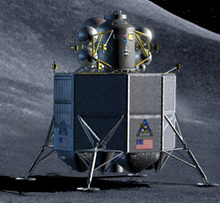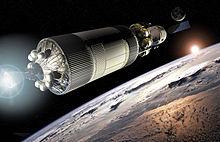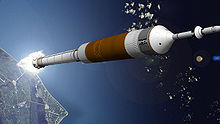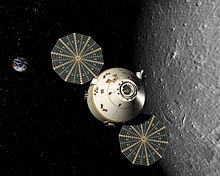Constellation program

Constellation is a human spaceflight program within NASA, the space agency of the United States. The stated goals of the program are gaining significant experience in operating away from Earth's environment, developing technologies needed for opening the space frontier and conducting fundamental science.[1] Constellation was developed through the Exploration Systems Architecture Study, which determined how NASA would pursue the goals laid out in the Vision for Space Exploration and the NASA Authorization Act of 2005.
As part of the Constellation program, NASA plans to develop spacecraft and booster vehicles to replace the Space Shuttle and send astronauts to the Moon and possibly to Mars as well. Currently, NASA is in the process of designing two boosters, the Ares I and Ares V. Ares I will have the sole function of launching mission crews into orbit. Ares V will be designed to launch other hardware for use on missions and will have a heavier lift capacity than the Ares I booster. In addition to these two boosters, NASA is designing a set of other spacecraft for use during Constellation. These will include the Orion crew capsule, the Earth Departure Stage and the Altair lunar lander.[2] Concerned by price increases on the program, U.S. President Barack Obama ordered a review of the project and found out that going to Mars or returning to the Moon is out of NASA's budget. [3]
Spacecraft
Orion
Orion is being designed as the crew compartment for the Constellation program. Orion will consist of two main parts, a Crew Module (CM) similar to the Apollo Command Module but capable of holding four to six crew members, and a cylindrical Service Module (SM) containing the primary propulsion systems and consumable supplies. The Orion CM will be reusable for up to 10 flights, allowing NASA to construct a fleet of Orion crew modules.
NASA is currently planning on developing different Orion capsules tailored for specific missions. The Block I Orion will be employed for International Space Station crew rotation and resupply and other Earth orbit missions. The Block II and III variants will be designed for deep-space exploration.
Lockheed Martin was selected as the prime contractor to build Orion on August 31, 2006.[4] Boeing was selected to build the primary heat shield for the Orion crew exploration vehicle on September 15, 2006.[5]
Altair

Altair (formerly known as the Lunar Surface Access Module, LSAM) will be the main transport vehicle for lunar-bound astronauts. Altair will be much larger than the Apollo lunar lander, almost 5 times larger, occupying a total volume of 1,120 ft³ (31.8 m³) as compared with the Apollo lander's much smaller volume of 235 ft³ (6.65 m³). It will stand 32 ft (9.7 m) tall and 49 ft (14.8 m) wide from lander tip to lander tip.
Like its Apollo Lunar Module (LM) predecessor, Altair consists of two parts: an ascent stage which houses the four-person crew, and a descent stage which has the landing legs, the majority of the crew's consumables (oxygen and water), and scientific equipment. Unlike the Apollo LM, Altair is to touch down in the lunar polar regions favored by NASA for future lunar base construction.[6] Altair, like the LM, is not reusable and is discarded after use.
The Altair descent stage will be powered by four RL-10 rocket engines that are currently used for the Centaur upper stage used on the Atlas V rocket . Unlike the current RL-10 engines in use, the newer RL-10s would be able to throttle down to as low as 10% rated thrust (the current specifications allow for 20%), thus allowing the use of Altair for both the lunar orbit insertion (LOI) and landing stages of the lunar mission. The ascent stage will be powered by a single engine, likely a hypergolic engine similar or identical to the main engine of the Orion CSM, using the descent stage as a launchpad, and as a platform for future base construction. There remains a small possibility that the original plan of using LOX/CH4 - fueled engines on board the Block II (lunar) Orion CSM and Altair ascent stage will come to pass; however, this appears very unlikely.
Earth Departure Stage

The Earth Departure Stage (EDS) is the main propulsion system that will send the Ares V Orion/Altair upper stage from low Earth orbit to the Moon. It is the second liquid stage of the Ares V rocket; Orion spacecraft will launch separately on Ares I, rendezvous and dock with the Ares V EDS/Altair combination, which will then be configured for the journey to the Moon (known as Earth orbit rendezvous).
Ares boosters

1. Space Shuttle payload includes crew and cargo.
2. Ares I payload includes only crew and inherent craft.
3. Saturn V payload includes crew, inherent craft and cargo.
4. Ares V payload includes only cargo and inherent craft.
Unlike the Saturn V and Space Shuttle, where the crew and cargo were launched together on the same rocket, the Constellation program is planned to use two separate launch vehicles — the Ares I for crew and the Ares V for cargo. This allows the two launch vehicles to be optimized for their respective missions, especially for a much heavier cargo load per mission. Constellation therefore combines the Lunar Orbit Rendezvous used by Apollo with the Earth Orbit Rendezvous mode.
Ares I

As currently envisioned, the Orion spacecraft will be launched into a low earth orbit using the proposed Ares I rocket (the "Stick"). Formerly referred to as the Crew Launch Vehicle (CLV), the Ares I consists of a single Solid Rocket Booster (SRB) derived from the boosters used in the Space Shuttle system, connected at its upper end by an interstage support assembly to a new liquid-fueled second stage powered by an uprated Apollo-era J-2X rocket engine.
Ares V
Ares V will have a maximum payload capacity of about 188 tonnes (414,000 lb) to Low Earth orbit (LEO), compared to the Space Shuttle's capacity of 24.4 tonnes, and the Saturn V's 118 tonnes. The Ares V will be able to carry about 71 tonnes (157,000 lb) to the Moon.[7][8]
Ares V will incorporate five RS-68 engines with assistance from a pair of five-segment SRBs. Five Space Shuttle Main Engines were originally planned for the Ares V, but the RS-68 engines are more powerful and less complex and therefore less expensive than the SSMEs. The Ares V will fly for the first eight minutes of powered flight, while the EDS will place itself and the Altair spacecraft into low Earth orbit while awaiting the arrival of the Orion.
Based on the Saturn V's S-IVB upper stage, the EDS is in essence an enlarged S-IVB with larger LOX/LH2 tanks and is powered by the same J-2X engine already being planned for the Ares I. The EDS, while primarily being designed for its lunar role (and eventual Mars role), can also launch large modules in support of the International Space Station. With the Altair removed and a docking collar added, it can allow an Orion to change its orbital inclination and altitude (either the standard 29-degree orbit or the 51.5-degree ISS orbit) to that of a Sun-synchronous, Clarke, or near polar orbit in a manner originally planned for the Apollo Applications Program.[citation needed]
The EDS, teamed with an Altair-derived or even a Centaur upper stage, could also be used to launch large space probes in the same weight class as Galileo and Cassini-Huygens to Uranus, Neptune, and any trans-Neptunian object (TNO) using direct-trajectory profiles similar to that used on the Voyager spacecraft. For instance, it could launch the now canceled Jupiter Icy Moons Orbiter mission directly to the moons of Jupiter. It could also support a Mars Sample Return mission with direct descent and ascent from Mars surface, without the complication and technical challenge of a rendezvous in Mars orbit.[citation needed]
Missions
This section needs additional citations for verification. (September 2008) |
Like that of the Apollo Program, Project Constellation will involve its main vehicle, the Orion spacecraft, flying missions in Low-Earth Orbit (LEO) with an emphasis of servicing the International Space Station, and in conjunction with the Altair lunar lander and Earth Departure Stage, on flights to the polar regions of the Moon. As of 2008[update], there are no well-defined plans for a manned flight to Mars, as flights to the Red Planet will most likely not occur before 2030, but a mission to a Near-Earth asteroid is in the initial planning phase.
It has been suggested that Orion Asteroid Mission be merged into this article. (Discuss) Proposed since August 2009. |
It has been suggested that Orion Mars Mission be merged into this article. (Discuss) Proposed since August 2009. |
International Space Station & Low-Earth Orbit Flights
After being brought together at the Kennedy Space Center from various parts of the country (Utah and Louisiana for the Ares I booster, and various Lockheed Martin facilities in the Southern U.S. for the Orion) and completion of major testing, including spacecraft integrity testing in a vacuum chamber, the components of the Orion/Ares I stack are assembled in the Vehicle Assembly Building in a manner similar to that of the stacking and assembly of both the Shuttle and the Saturn IB and Saturn V rockets.
Once assembly is completed and a launch date is set, the Crawler-Transporter picks up and transports both the completed Orion-Ares I stack, along with the launch support tower and the Mobile Launcher Platform (purposely built for the Ares I, as the Apollo/Shuttle MLP will be refurbished for the Ares V) out to Launch Pad 39B, which is currently undergoing conversion from Shuttle missions to Ares I operations. Once the Crawler-Transporter reaches the pad, the Ares I and its platform is left in place and the Crawler-Transporter is taken to a safe, yet reasonable distance in order to facilitate pickup of the platform for an equipment rollback to the VAB.
After final checks, the ground crew then fills up the second stage with liquid hydrogen (LH2) and liquid oxygen (LOX), with the crew, suited up in new all-purpose spacesuits, entering the spacecraft only three hours before liftoff. Once locked in and all systems are cleared by controllers at both the Cape and Mission Control in Houston, the Ares I is then launched, clearing the launch tower and (after a roll program and pitch over), heads out on the proper trajectory, depending upon the mission.
At T+120 seconds into the flight, the solid-fueled first stage is jettisoned for recovery, and the onboard J-2X engine is ignited, followed 30 seconds later by the jettisoning of both the launch abort system and the fairings covering the Orion crew and service modules. At T+330 seconds after liftoff, the J-2X engine cuts off and the Orion spacecraft enters an initial entry orbit, which, 45 minutes later, is circularized by a second burn of the onboard J-2X engine, after which the Orion spacecraft separates (allowing the second stage to burn up in the atmosphere) and extends a pair of paddle-shaped solar panels.
After a two-day chasedown, the Orion spacecraft meets up with the International Space Station, and then, after getting the go ahead from Houston, docks with the ISS. The six-man crew, the largest number that can fly on an Orion spacecraft, then enters the station and performs numerous tasks and activities for the duration of their flight, usually lasting six months, but can be shortened to four or lengthened to eight, depending upon NASA's goals for that particular ISS Expedition. Once completed, the crew then reenters the Orion, which has been kept attached to the station as an emergency "lifeboat," seal off the hatches between it and the ISS, and then undock from the station.
Once the Orion reaches a safe distance from the ISS (but allowing a margin in the event the crew needs to return in an emergency), the spacecraft will turn around so the main engine faces forward and fire its onboard Aerojet AJ-10 engine. After the deorbit burn has been completed, the service module is then jettisoned, allowing it to burn up in the atmosphere while the crew module re-enters in the same manner as all NASA spacecraft prior to the Shuttle, using the ablative heat shield to both deflect heat from the spacecraft and to slow it down from a speed of 28,000 km/h (17,500 mph or Mach 25) to 480 km/h (300 mph or Mach 0.5). After reentry is completed, the forward assembly is jettisoned, and two drogue parachutes will be released, followed at 20,000 feet by three main parachutes and airbags filled with nitrogen (N2), which does not combust when exposed to heat, allowing the spacecraft to splashdown.[9] The Orion CM is then returned to Kennedy Space Center for refurbishment for a later flight. Unlike the Apollo CM, which was used only for one flight, an Orion CM can be used up to 10 times under normal operating conditions.
Lunar Sortie/Outpost Flights

Unlike the Apollo flights, when both the Apollo Command/Service Module and the Apollo Lunar Module were launched together on the Saturn V rocket, the first phase of a lunar mission will occur with the launch of the Shuttle-derived Ares V. Like the Ares I, the Ares V will be assembled at the Vehicle Assembly Building, but upon approaching the launch date, the Ares V would then be transported to Launch Pad 39A, the same launch pad used by NASA to launch the Apollo 11 spacecraft on its history-making mission. Upon giving the clearance to launch, the five RS-68 engines will ignite and upon verification by the on-board computer, the twin five-segment SRBs will ignite. At the same time, the EDS swing arms and Ares V core stage collect "chocks" will retract, and the booster will then lift off from the pad.
After clearing the tower, the Ares V will perform a roll maneuver and travel due east from the launch pad so that the orbital inclination is the same as the latitude of Cape Canaveral, 28.5°. This launch profile has the twin five-segment SRBs jettison at T+121.6 seconds into the flight, and the launch shroud separation occurring at T+295.0 seconds. After that, the main engines cutoff at T+329.0 seconds, and the subsequent jettison of the core stage occurs. Like the Space Shuttle External Tank, the spent core stage, with its RS-68 engine cluster, and the launch shroud, will burn up in the atmosphere over the Indian Ocean west of Australia. The EDS, powered by its single J-2X motor, will steer the Altair/EDS combination into a stable 360 km (approx. 225 mi) high circular orbit.
Approximately 90 minutes after the Ares V launch, the Orion-Ares I stack, on Pad 39B and transported approximately a day after the Ares V stack, will lift off from the adjacent launch pad at the same orbital inclination, jettisoning the SRB at 125.0 seconds after liftoff. The manned Orion CSM contained within Ares I will then dock with the Altair/EDS combination already in low-Earth orbit. After the systems are configured for lunar flight, the EDS will fire for the 390-second translunar injection (TLI) burn, which will accelerate the spacecraft stack from 28,000 km/h (17,500 mph) to 40,200 km/h (25,000 mph). Unlike the Apollo-Saturn TLI burn, the combined Orion/Altair-EDS TLI burn will be done in the "eyeballs out" fashion (with the astronauts being "pulled" from their seats) similar to that envisioned with the never flown Manned Venus Flyby mission planned during the Apollo Applications Program in the late 1960s. After the TLI burn, the EDS is jettisoned, and either enters into an orbit around the Sun or is steered into a slightly different trajectory to crash into the lunar surface (similar to that employed by the S-IVB stages from Apollos 13 to 17). During the three-day trans-lunar coast, the four-man crew will monitor the Orion's systems, inspect their Altair spacecraft and its support equipment, and, if necessary, change their trajectory to allow the Altair to land in a near-polar landing site suitable for a future lunar base.
Three days after TLI, the Orion/Altair combination, approaching the lunar far side, will orient the Altair's engines in the proper direction for the lunar orbit insertion (LOI) burn to begin. Once in orbit, the crew will refine the trajectory and configure the Orion CSM for unmanned flight, upon which all of the crew members will transfer to the Altair, and upon receiving clearance from Mission Control, will then undock from the Orion. After the Altair undocks, it then performs an "inspection maneuver," allowing controllers, via a live TV feed, to inspect the spacecraft for any anomalies that may have occurred during launch or the trans-lunar coast; formerly this was done by the Command Module Pilot (CMP) on Apollo missions. Once the subsequent separation maneuver is completed, the unmanned Orion CSM is placed in a 95 to 110 km (approx. 60 to 70 mi) high circular orbit to wait for the Altair's return.
After receiving approval from ground controllers, the four RL-10 engines on the Altair's descent stage will fire again, and like that of Apollo LM, the crew will land their Altair in a pre-determined landing spot that will have been scouted out before by unmanned spacecraft. Upon landing, the crew will don their moonwalking spacesuits and commence the first of five to seven lunar EVAs collecting samples and deploying experiments.
After completing their Lunar Sortie operations, the crew will enter the Altair's ascent stage and lift off from the Moon's surface, powered by a single ascent engine (likely a hypergolic engine similar to that used on the Orion CSM), while using the descent stage as a launchpad (and as a platform for future base construction). Upon entering orbit, the Altair docks with the waiting Orion spacecraft, and the crew then transfers themselves and any samples collected on the moon over to the Orion. After jettisoning the Altair to allow it to crash into the lunar far side, the crew, using the onboard AJ-10 engine, performs the all-important Trans Earth Injection (TEI) burn for the return trip to Earth. After a 2½ day coast, the crew jettisons the service module (allowing it to burn up in the atmosphere) and then reenters the Earth's atmosphere using a special reentry trajectory designed to both slow the vehicle from its speed of 40,200 km/h (25,000 mph) to 480 km/h (300 mph) and allow for a West Coast landing. The Orion CM will then splashdown in the same manner as an ISS-bound flight, and like the flights to the ISS, the Orion crew module will then be flown back to KSC for refurbishment while lunar samples are routed to the Johnson Space Center's (JSC) Lunar Receiving Laboratory for analysis.
Alternatives
A number of alternatives to Constellation have been suggested in response to critiques of the program. The two most notable are the Ares IV booster and the DIRECT architecture.
Ares IV
In January 2007, NASA announced that a different launch vehicle design, the Ares IV, was being studied for the program.[10] The Ares IV combines an Ares I upper stage with an Ares V first stage and could be used to reach the Moon.[11]
DIRECT
The DIRECT launch vehicle concept uses existing shuttle components, such as the solid rocket boosters and the external tank, with minimal development of new hardware.
See also
- Exploration Systems Architecture Study
- NASA's Vision for Space Exploration
- Crew Space Transportation System (CSTS), European-Russian counterpart of the CEV and the Vision of Space Exploration
- SpaceX Dragon, Space capsule currently under development by SpaceX corporation for NASA's COTS program.
References
- ^ Connolly, John F. (2006). "Constellation Program Overview" (PDF). Constellation Program Office. Retrieved July 6, 2009.
{{cite web}}: Unknown parameter|month=ignored (help) - ^ "Exploration Systems Architecture Study - Final Report" (PDF). NASA. 2005. NASA-TM-2005-214062. Retrieved July 6, 2009.
{{cite web}}: Unknown parameter|month=ignored (help) - ^ Art Chimes. "Expert Group Says NASA Budget Too Small for Big Space Plans". VOA News. Retrieved September 1,2009.
{{cite news}}: Check date values in:|accessdate=(help) - ^ "NASA Selects Orion Crew Exploration Vehicle Prime Contractor" (Press release). NASA. August 31, 2006. Retrieved July 6, 2009.
- ^ "NASA Awards Thermal Protection Contract for Orion Spacecraft" (Press release). NASA. September 15, 2006. Retrieved July 6, 2009.
- ^
Jim Banke (2008). "Orion vs. Apollo: NASA's 21st Century Moonshot". Space.com. Retrieved 2008-12-11.
{{cite web}}: Italic or bold markup not allowed in:|publisher=(help) - ^ Overview: Ares V Cargo Launch Vehicle, NASA. Retrieved 30 September 2008.
- ^ Steve Creech, Steve and Phil Sumrall. "Ares V: Refining a New Heavy Lift Capability". NASA.
- ^ Chris Bergin (2007). "Orion landings to be splashdowns - KSC buildings to be demolished". NASA SpaceFlight.com. Retrieved 2007-08-05.
{{cite web}}: Italic or bold markup not allowed in:|publisher=(help) - ^ Rob Coppinger (2007). "NASA quietly sets up budget for Ares IV lunar crew launch vehicle with 2017 test flight target". Flight International. Retrieved 2008-12-11.
{{cite web}}: Italic or bold markup not allowed in:|publisher=(help) - ^ Brian Berger (2007). "NASA Studies Early Moon Shot for New Space Capsule". Space.com. Retrieved 2008-02-11.
{{cite web}}: Italic or bold markup not allowed in:|publisher=(help)


